Anthony Friedkin
- Photographer Anthony Friedkin
- Photographs
- Contributor Kristine Jingozian
Artist Biography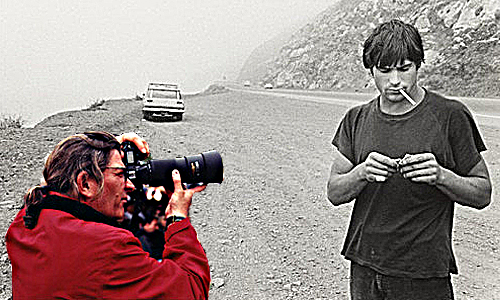
Anthony Friedkin, a Los Angeles native, has been photographing since he was a child. Friedkin first began work in a darkroom at the ripe old age of eleven. Working primarily in film, Friedkin’s black and white prints depict and celebrate the people and scenery of Southern California.
Friedkin’s acclaimed “Gay Essay” portrays “out” gay people who are comfortable with their lifestyles and refuse to conform to societal norms. Friedkin depicts Queer culture with an air of dignity and the intention of capturing the honesty of his subjects. “The Gay Essay” was not shown in America for a long time due to the sensitivity of the images Friedkin produced and a less than receptive society whose mainstream was overwhelmingly homophobic, simply put, but was exhibited in Europe and East Asia and was received well. The photographic essay was captured in the years when sexual revolution was taking a stronghold, around the time of the Stonewall riots. Friedkin began his work on the “Gay Essay,” when he was only nineteen years of age, and set out “to depict [the] struggles, humiliations, and [the] triumphs [of queer culture]" (DRKRM.Gallery 2009). Friedkin’s goal was to document what it meant to defy the grain when it is wrong, that is to show the courage it takes to define one’s own freedom and individuality (DRKRM.Gallery).
Friedkin’s work is honest. His subjects are shown to be what and who they are without any attempt to sugarcoat. The beauty in Friedkin’s images consists in the compassion and respect he has for his subjects. For Friedkin’s audience, the elevation of the photographic subject to an artwork is immediately obivous. His photographs are not attempts at beauty so much, although they result in beauty, but at honesty; each photograph is an essay of its own to describe the truth of a fleeting moment. As a result, Friedkin reveals the subject and the many layers of the subject’s reality and does not sugarcoat or vandalize the subject. His ability, however, to capture the right moment can be atttributed to his steadfastness to film photography, which requires observation and patience for the right moment.
Bibliography
Knight, Christopher. "'Gay, A Photographic Essay 1969-1972' at Drkrm.gallery." Los Angeles Times. Los Angeles Times, 10 July 2009. Web. 28 Nov. 2012. <http://articles.latimes.com/2009/jul/10/entertainment/et-galleries10>.
Jerikstl. "Forces of Nature." Calso Magazine. Wordpress, 10 Feb. 2012. Web. 28 Nov. 2012. <http://calsomagazine.com/wordpress/?p=65>.
"Anthony Friedkin | Gay, A Photographic Essay." DRKRM.GALLERY. DRKRM.GALLERY, 2009. Web. 28 Nov. 2012. <http://www.drkrm.com/friedkin.html>.
"Anthony Friedkin: Biography." Dnj Gallery. Dnj GAllery, n.d. Web. 28 Nov. 2012. <http://www.dnjgallery.net/popup_afriedkin_bio.html>
Photographs
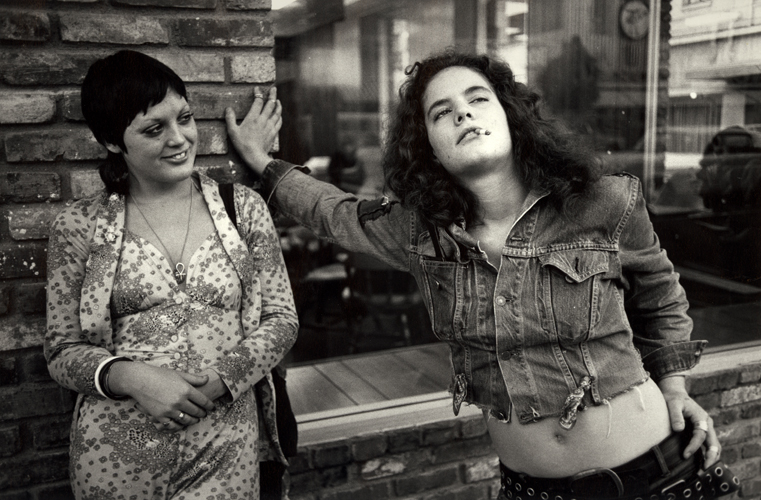
Lesbian Couple, Hollywood, 1972, Gelatin silver print 11x14 inches.
Image url: http://latimesblogs.latimes.com/culturemonster/2012/03/pst-a-to-z-cruising-the-archive-at-one-national-gay-and-lesbian-archives.html
In “The Gay Essay”, Friedkin’s aim was to explore openly queer people and photograph them in a light which celebrated their pride and their bravery. “Lesbian Couple,” depicts two women in Hollywood, who are clearly in love and proud of it. The woman on the left looks lovingly at her partner, who is posing proudly beside her. There is a pronounced tenderness in this photograph between the two people, which is almost too intimate to be shared. Most striking about the couple in the photo is the space between the two bodies, but yet the closeness they share. Friedkin captures a triumph in this photograph. The photograph pays respect to these two women and dignifies their love.
Friedkin’s work as the photographer is to accept and express his voice as the artist. This photograph is a tender one in a series of others which teeter on the edge between celebration and documentary. The relevance of this photograph within the essay is that the love between the two women in this photograph is what makes the struggles depicted in some of the other works worthwhile. This photo documents and archives into evidence that glimmer of hope that keeps people fighting for what is right.
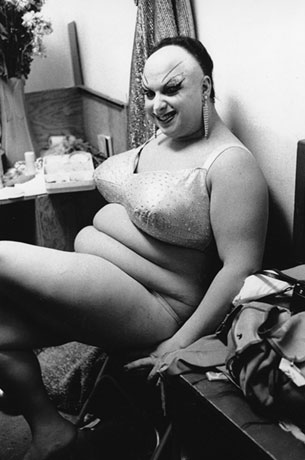
Divine, Palace Theatre, San Francisco, 1972, Gelatin silver print 11x14 inches.
Image url: http://www.drkrm.com/friedkin.html
Divine, a “cross-dressing actor made famous in John Waters' early movies,” is another character of triumph (Knight 2009). In the photograph, Divine reclines on a dressing room chair at the Palace Theatre, grinning widely. Divine is another triumph in the essay, totally secure with himself despite the many reasons not to be. This photograph is unsettling at first thanks to the “post-Bozo-the-Clown eye makeup,” however after closer examination it becomes clear that Divine is the epitome of gay (or more inclusively, Queer) pride (Knight 2009). So, the unsettling makeup within the context of the character now symbolizes the strength and integrity involved with being true to oneself. Divine’s seemingly overt pose and exaggerated makeup are indicative of something deeper than just pride—they indicate complete security with one’s image.
Divine is not presented to the viewer as an individual who adheres to traditional ideals of beauty, but is beautiful in terms of confidence and what it means to be secure with oneself. Furthermore, Divine represents the artful, which cannot be confined to societal values, and is a beacon of creativity, celebrating individuality. With Divine, Friedkin has given the art world and queer culture another character to celebrate and by which to be inspired.
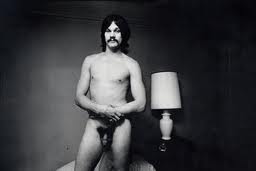
Dan, Male prostitute, San Fernando Valley,1972, Gelatin silver print 11x14 inches.
Image url: http://www.drkrm.com/friedkin.html
Dan, a male prostitute, working out of the San Fernando Valley, stands naked before the viewer challenging the notion of traditional masculinity. Dan does not look uncomfortable or shaken in the least and is presumably used to being exposed in front of strangers, but what is striking about the attitude of the nude man in the photograph is that he does not seem to be shy about himself or his work or the fact that he stands alone atop a bed, a lamp on the wall his only company.
While Dan is nude for other reasons than the average nude art model, it should be noted that this photograph does not criticize him for his nudity, but rather studies him as a nude within a social context, elevating him, the subject, to work of art. The photograph is less an inspiration and more a kick in the head for the viewer. It forces the viewer to confront some uncomfortable reality about the world which is undeniably an effective measure for inspiring change. While Friedkin’s work is not intended as activism (it is intended as documentary), this photograph reminds us, among with the other photographs in the essay, that the most powerful activism can be art.
Bibliography
Knight, Christopher. "'Gay, A Photographic Essay 1969-1972' at Drkrm.gallery." Los Angeles Times. Los Angeles Times, 10 July 2009. Web. 28 Nov. 2012. <http://articles.latimes.com/2009/jul/10/entertainment/et-galleries10>.
Jerikstl. "Forces of Nature." Calso Magazine. Wordpress, 10 Feb. 2012. Web. 28 Nov. 2012. <http://calsomagazine.com/wordpress/?p=65>.
"Anthony Friedkin | Gay, A Photographic Essay." DRKRM.GALLERY. DRKRM.GALLERY, 2009. Web. 28 Nov. 2012. <http://www.drkrm.com/friedkin.html>.
"Anthony Friedkin: Biography." Dnj Gallery. Dnj GAllery, n.d. Web. 28 Nov. 2012. <http://www.dnjgallery.net/popup_afriedkin_bio.html>
Contributor Autobiography
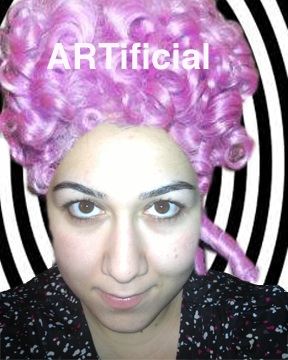
I am a native Angeleno majoring in Philosophy in my junior year at UCLA. Pierce College employs me to tutor daring Philosophy students and I am very proud of my work. Although I plan to teach someday, hopefully philosophy, I am and have been very interested in art my whole life. I would not label myself an artist, but I have taken several art classes and I appreciate what it takes to hone a craft and elevate it to art. I am particularly taken with activist art because expressed as art, activism tends to take a stronger hold in the psyche, which leads to more action. The ability of activist art to get people off their rumps is always inspiring. So, when presented with the chance to take a class that explores Queer Art in Los Angeles, I jumped at it. I enrolled in LGBTS 183 because it provides me, and my colleagues, the opportunity to explore a piece of Queer culture and document that exploration, which is unlike any class I have come across. Perhaps the most exciting aspect about this opportunity is that we have all been given the chance to learn about an artist who embraces the same values that we do. I am particularly fascinated with photography and Anthony Friedkin, the artist I chose to research, documents the world on film. Friedkin’s photography pays homage to the amazing people and the beautiful scenery of Los Angeles. My research pays special attention to Friedkin’s “The Gay Essay,” a photographic exploration of Queer culture in Los Angeles and San Francisco from 1969 to 1972. The three photographs which I chose to evaluate were “Lesbian Couple,” “Divine,” and “Dan, Male Prostitute.” My intention was to capture a range of Queer individuals.


